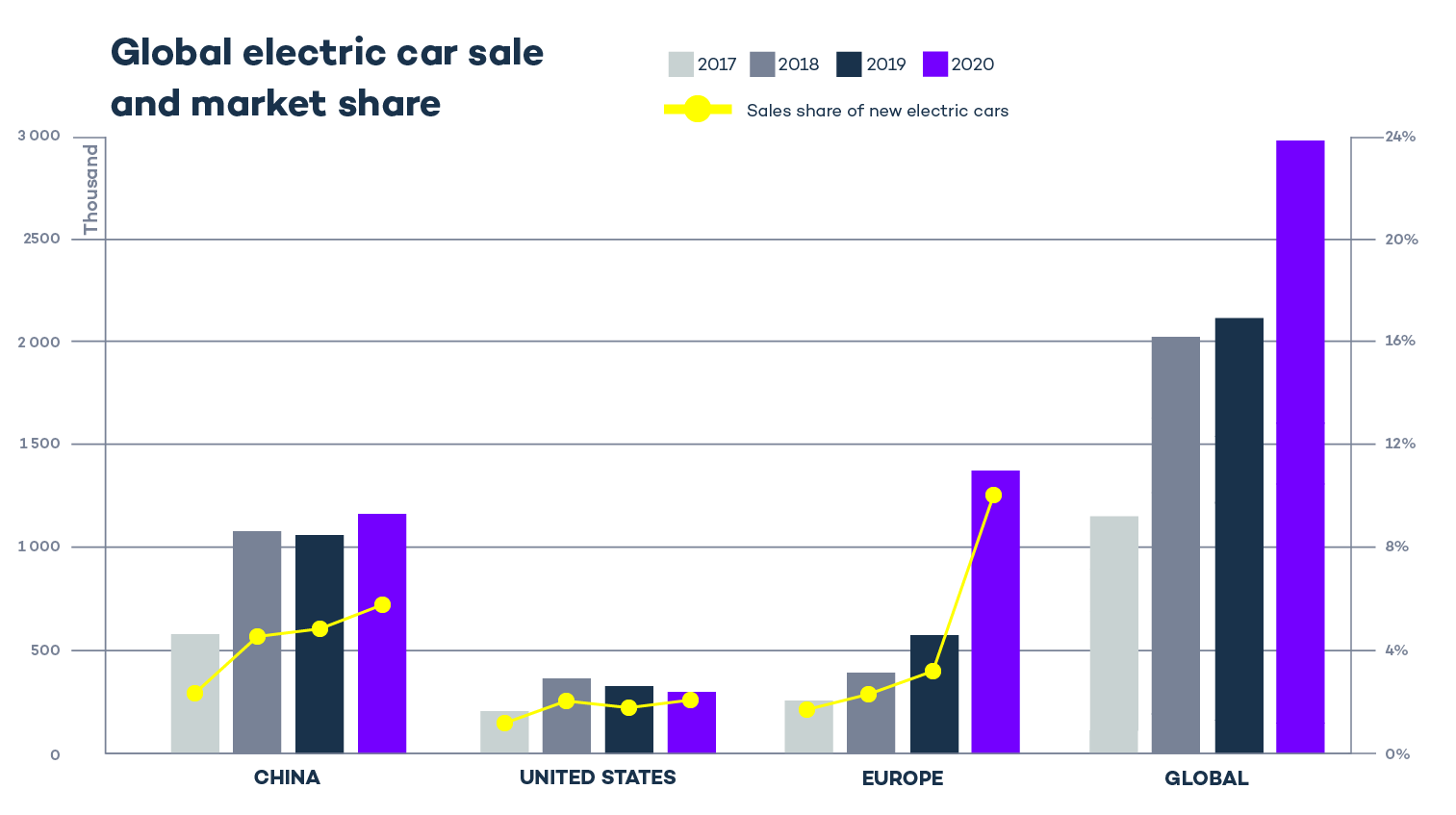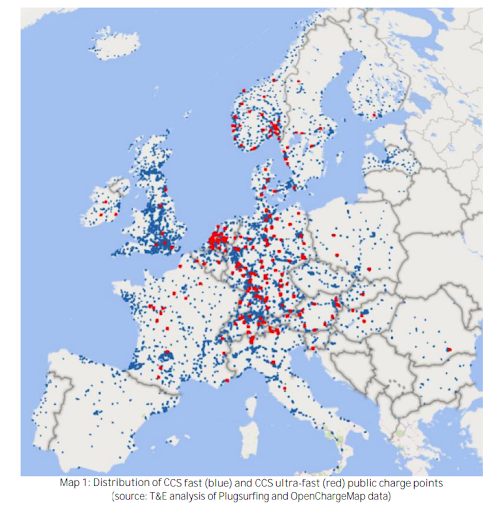The state of EV charging infrastructure in Europe by 2030
Backed by ambitious carbon emission-free measures and financial help with the European Green Deal, the EV market is booming in Europe. Now, is the EV charging infrastructure following the trend, or are we already lagging behind?
While more ICE cars are still sold compared to EVs, the ratio is expected to shift very soon everywhere:
- By 2025, it is expected 1 in 5 new cars sold to be electric (worldwide).
- By 2030, it is expected 2 in 5 new cars sold to be electric (worldwide).
In 2035 and beyond, in Europe (2040 in the rest of the world), it is expected that 100 % of new cars sold to be electric.
It means that we need to prepare the ground for tomorrow’s e-mobility and ensure that our charging infrastructures meet a demand that’s about to grow exponentially.
In this post, we’ll briefly look at the current status of the electric vehicle charging infrastructure in Europe and jump ten years ahead to share the latest estimates. We’ll also look into the actors who will carry the growth of EV charging in the coming years.
The current state of the EV charging infrastructure in Europe
A common fear among EV sceptics is range anxiety or the impossibility to cover long distances with an electric vehicle without stopping to charge or, worse, running out of energy in the middle of nowhere.
Fortunately, as the number of electric cars is growing on our roads, so are the public locations to charge their batteries.
The challenge of a decade: Developing public charging infrastructures to meet the demand
The latest EV sales numbers don’t lie; EV sales have never grown so fast globally, especially in Europe.

Now, change always takes time and, when taking a closer look, we can observe real disparities between countries.
Source: Transportenvironment.org (2021)
Norway (18.1 %), Iceland (5.5 %), Sweden (3.7 %), and the Netherlands (3.2 %) are leading in terms of the number of EVs sold compared to the total of all passenger cars on the road. China, Germany, the EU, and the US are leading the way regarding pure sales volume. This means that if EV is booming in some countries, it’s still relatively marginal on a broader scale. And, while the planet would be happier with a faster transition, it gives us time to get ready.
A strong charging network. Crossing Europe with an EV is not a fable anymore.
While some regions are better connected than others, the existing network of fast public chargers across Europe makes it possible for EV drivers to travel far and fast.
|
EV charging services providers like Virta make it possible for EV drivers to plug and charge their vehicles from different charging networks, thanks to roaming. Read more about roaming here: Why roaming is the buzzword in electric vehicle charging? |
 Source: Transportenvironment.org (2021)
Source: Transportenvironment.org (2021)
On average in 2021, the EU offers five fast public chargers for every 100 km.
When we know that most EVs can now easily travel 400+ km on a full charge, this should come as a relief for current and future EV drivers.
But are there really enough public chargers for everyone?
Yes, there are (tomorrow, we’ll need more, a lot more).
Another common argument against EV charging is the fear of queueing for long hours to access a public charging station. In 2014, an EU-appointed commission dictated that we aim for a maximum of 10 EVs per Public Charging Point (PCP) across Europe to ensure enough room for everyone to charge when needed.
In 2021, our current ratio is approximately 7.5 EVs per PCP, and we find that most countries already fall under the recommendations set by the EU in 2014.
Source: Transportenvironment.org (2021)
Even if electric cars are mostly charged at home and work, public electric car charging points are needed. We especially need fast chargers to support long-distance travel and reduce charging times to allow more EV drivers to use and share charging points.
Looking at the above chart, does it mean that we should worry about Finland and Sweden? No, it doesn’t. Finland, for instance, shows a 15 EVs per PCP ratio. It is, however, balancing by offering a large majority of public fast and ultra-rapid chargers (see on the next chart), thus decreasing the pressure on each charger. However, the United Kingdom might need to double down as 75 % of the public chargers are slow 3-7 kWh charging stations.
What about tomorrow? Optimistic targets for 2030 and beyond
If we want to stay within (or close to) the recommended limit of 10 EVs per public charging point, we need more EV charging infrastructures. Fortunately, the latest estimates seem to show that we should meet the EV charging demand in Europe.
1.3 million public charging stations by 2025. 2.9 million by 2030.
Deploying another 2.7 million public charging points in Europe by 2030 would require an investment averaging €1.8 billion (or only 3 % of the EU's annual budget for roads and infrastructure).
Source: Transportenvironment.org (2021)
Source: Transportenvironment.org (2021)
An EV per PCP in between 11 and 14 in 2030
The COVID-19 pandemic seems to have had a positive impact on EV sales. Pre-pandemic, early research estimated that 33M EVs would roam around Europe by 2030. Now, Pandemic-adjusted research shows that we’re looking at 40M electric vehicles driving around the continent by 2030.
Of course, while quantity is necessary, so is quality. We expect batteries and charging technologies to improve as we move forward, thus making the 2014 ratio less relevant.
Business as the fuel for EV charging infrastructure growth
As more electric vehicles roam in Europe, we’ll naturally see an increase in charging stations options all around the continent. Think about it; where and when do ICE drivers refill their vehicles' tanks?
- At independent petrol and service stations when on the move.
- Before or after shopping.
EV drivers don’t behave any differently (with a little twist, however). EV drivers are plugging their EVs:
- When on the move, using fast and ultra-fast chargers.
- While they shop.
- While at home or the office.
The moment of the charging event makes all the difference here. EV drivers will shop where they can charge their batteries.
This represents an immense opportunity to generate new revenue streams for petrol station owners, retail chains, real estate professionals, or even parking owners.
Ready to learn more?
The EV revolution is (finally) here.
Change is always slow - especially when it's fuelled by early investments. However, all seems to indicate that we are ready t deploy the necessary infrastructure to reassure future EV drivers and support and increase growth in EV sales.
New content alerts
You may also like
These related stories
/professional-businessman-with-ev-city-background.webp?width=1920&height=1080&name=professional-businessman-with-ev-city-background.webp)
50kW charging – How will the fast-charging market evolve?
/businessman-charging-electric-car-city.webp?width=1920&height=1080&name=businessman-charging-electric-car-city.webp)
Increase revenue & utilisation rates with high-power EV charging (HPC)
/wind-turbines-road-night-car-light-trails.webp?width=1920&height=1080&name=wind-turbines-road-night-car-light-trails.webp)
Why we must charge EVs with renewable electricity
/businessman-charging-blue-electric-vehicle-beside-urban-building.webp?width=1920&height=1080&name=businessman-charging-blue-electric-vehicle-beside-urban-building.webp)

